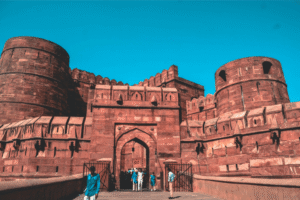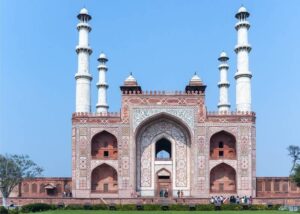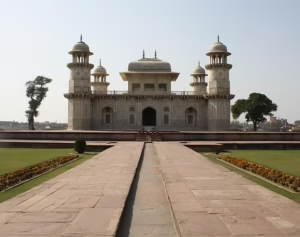Taj Mahal: India’s Crown Jewel and UNESCO Heritage Site
The Taj Mahal, an immense mausoleum of white marble, built in Agra between 1631 and 1648 by order of the Mughal Emperor Shah Jahan, is The Taj Mahal is the finest example of Muslim art in India and one of the most admired masterpieces in the world. The Taj Mahal is located on the right bank of the Yamuna River in a vast Mughal garden that encompasses nearly 17 hectares,in the Agra District in Uttar Pradesh.
The mausoleum is located on the right bank of the river Yamuna at a point where it takes a sharp turn and flows eastwards. Originally, the land where the Taj Mahal presently stands belonged to the Kachhwahas of Ajmer .
Location of tajmahal
located on the right bank of the Yamuna River in a vast Mughal garden that encompasses nearly 17 hectares,in the Agra District in Uttar Pradesh.
How to reach
By train : apart from the main railway station at Agra Cantonment, the city also has two other stations—Raja-ki-Mandi and Agra Fort. Furthermore, the main trains linking Agra with Delhi are Palace on Wheels, Shatabdi, Rajdhani, and Taj Express.
By air : The fastest way of reaching Taj Mahal, Agra is by air. The city of Taj, Agra, has its own airport that is around 7 km from the city center. Indian Airlines operates flights to Agra on a daily basis.
By road : There are regular bus services from Agra to a number of important cities. The main bus stand of Idgah has a number of buses running for Delhi, Jaipur, Mathura, Fatehpur-Sikri, etc. if you are coming from Delhi to Agra. you can hire Delhi to Agra Taxi on specail discounts.
Famous for :
It was built by Mughal Emperor Shah Jahan in memory of his wife Mumtaz Mahal with construction starting in 1632 AD and completed in 1648 AD, with the mosque, the guest house and the main gateway on the south, the outer courtyard and its cloisters were added subsequently and completed in 1653 AD. The Taj Mahal is seen as the greatest achievement of Indo-Islamic architecture.
History and significance ofb tajmahal
The Taj Mahal is a Mughal mausoleum built in India during the Mughal era. It is known as a ‘Wonder of the World’, a ‘Symbol of Love’, and a ‘UNESCO World Heritage Site’. It is one of the most searched landmarks on the internet and attracts millions of its admirers from around the globe.
architectural style of the Taj Mahal
The Taj Mahal follows authentic Mughal architecture with symmetrical designs, and minarets as prominent elements of the building. he Taj Mahal reflects true Mughal architecture with symmetrical designs and tall minarets as key features. The monument is built with Makrana White Marble decorated with fine artwork, while the other buildings in the complex are made of Red Sandstone.
Iconic places near the Taj Mahal
The Taj Mahal is surrounded by several other significant monuments that were built during the Mughal era.
Agra Fort
The Agra Fort is a Mughal fort built by Emperor Akbar, who was Shah Jahan’s grandfather. It is a large fort made of Red Sandstone, and moreover, it includes many buildings from that time. This fort is also a UNESCO World Heritage Site.

Akbar’s Tomb, Sikandra
The tomb of Akbar situated at Sikandra is one place a traveler cannot miss to visit while paying a visit to the Taj Mahal. T he Itimad-ud-Daula’s Tomb is situated on the left bank of river Jamuna next to Chini-ka-Rauza. Itimad-ud-Daula was the title given to Mirza Ghiyath Beg, father of Nur Jahan.

Itmad-Ud-Daula Tomb
T he Itimad-ud-Daula’s Tomb is situated on the left bank of river Jamuna next to Chini-ka-Rauza. Itimad-ud-Daula was the title given to Mirza Ghiyath Beg, father of Nur Jahan. He was first the Lord of Treasure of the empire and later became the Wazir under Jahangir. After his death, Nur Jahan completed the construction of his tomb in 1628 AD, about seven years later.

Fatehpur Sikri :
Fatehpur Sikri is located in Agra District in the State of Uttar Pradesh in northern India. It was constructed southeast of an artificial lake, on the slopping levels of the outcrops of the Vindhyan hill ranges. Known as the “city of victory”. It was made the capital by the Mughal emperor Akbar (r. 1556–1605 CE), and moreover, it was constructed between 1571 and 1573.

Other Attractions :-
Some of the most famous places of the city include the Jama Masjid, Guru Ka Tal, Chini ka Rauza and the Mehtab Bagh, Vrindavan .

